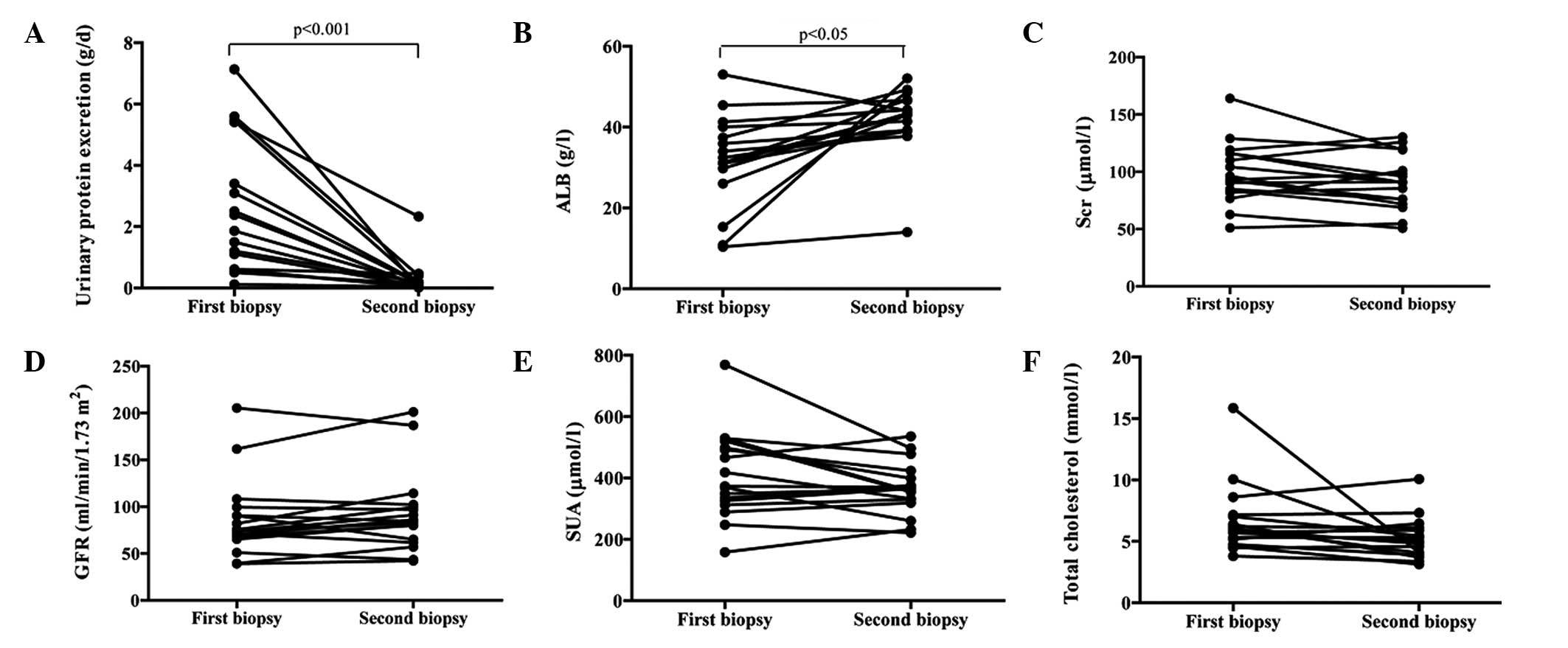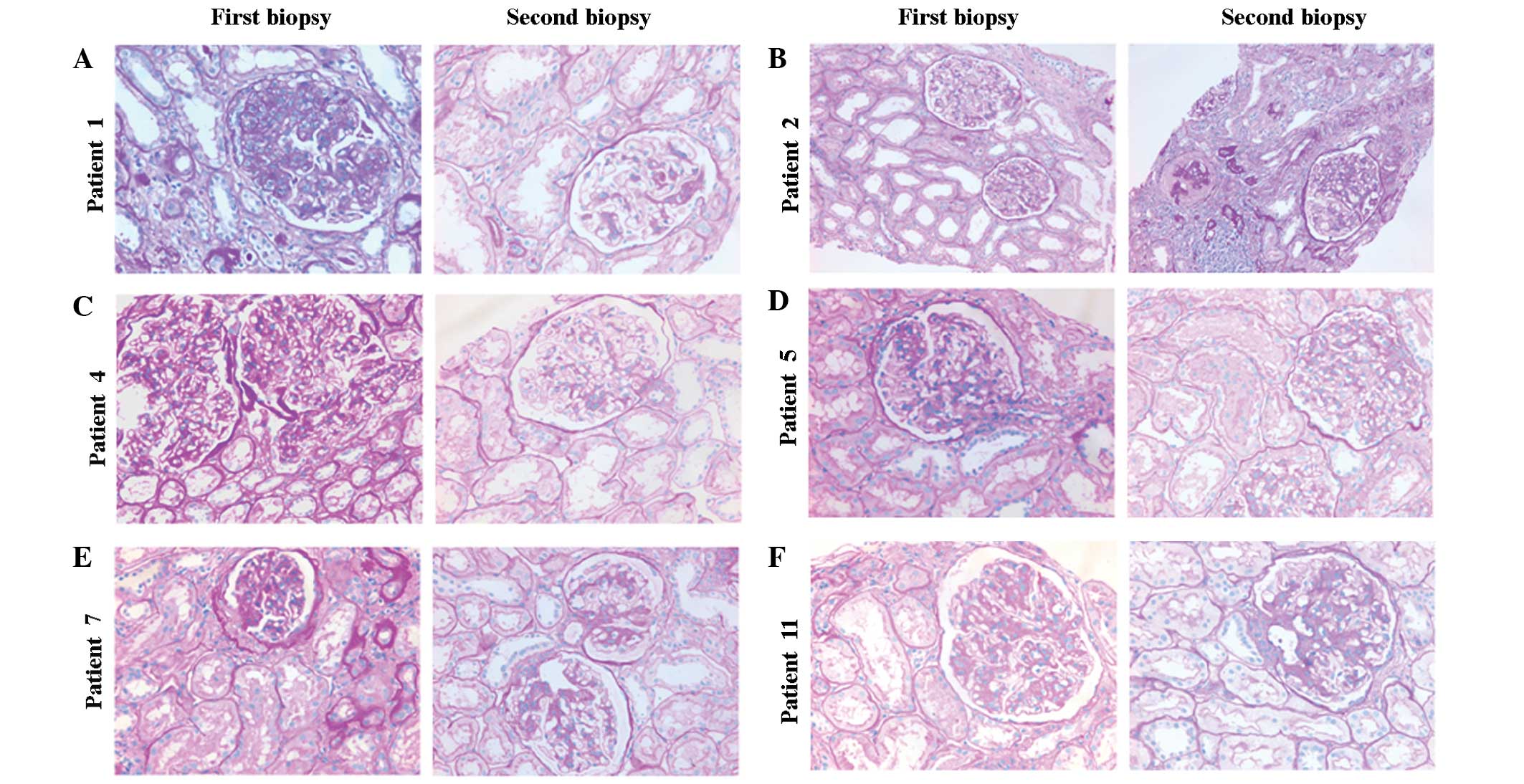|
1
|
Floege J and Feehally J: IgA nephropathy:
recent developments. J Am Soc Nephrol. 11:2395–2403.
2000.PubMed/NCBI
|
|
2
|
Donadio JV and Grande JP: IgA nephropathy.
N Engl J Med. 347:738–748. 2002. View Article : Google Scholar : PubMed/NCBI
|
|
3
|
Reich HN, Troyanov S, Scholey JW and
Cattran DC; Toronto Glomerulonephritis Registry. Remission of
proteinuria improves prognosis in IgA nephropathy. J Am Soc
Nephrol. 18:3177–3183. 2007. View Article : Google Scholar : PubMed/NCBI
|
|
4
|
D’Amico G: Natural history of idiopathic
IgA nephropathy and factors predictive of disease outcome. Semin
Nephrol. 24:179–196. 2004.PubMed/NCBI
|
|
5
|
Berthoux F, Mohey H, Laurent B, Mariat C,
Afiani A and Thibaudin L: Predicting the risk for dialysis or death
in IgA nephropathy. J Am Soc Nephrol. 22:752–761. 2011. View Article : Google Scholar : PubMed/NCBI
|
|
6
|
Coppo R, Cattran D, Roberts Ian SD, et al:
The new Oxford Clinico-Pathological Classification of IgA
nephropathy. Prilozi. 31:241–248. 2010.PubMed/NCBI
|
|
7
|
Pozzi C, Bolasco PG, Fogazzi GB, et al:
Corticosteroids in IgA nephropathy: a randomised controlled trial.
Lancet. 353:883–887. 1999. View Article : Google Scholar : PubMed/NCBI
|
|
8
|
Harmankaya O, Oztürk Y, Baştürk T, Obek A
and Kiliçarslan I: Efficacy of immunosuppressive therapy in IgA
nephropathy presenting with isolated hematuria. Int Urol Nephrol.
33:167–171. 2002. View Article : Google Scholar : PubMed/NCBI
|
|
9
|
KDIGO: Kidney Disease: Improving Global
Outcomes. KDIGO Clinical Practice Guideline for Glomerulonephritis.
Kidney Int. 2(suppl): 209–217. 2012.
|
|
10
|
Manno C, Torres DD, Rossini M, Pesce F and
Schena FP: Randomized controlled clinical trial of corticosteroids
plus ACE-inhibitors with long-term follow-up in proteinuric IgA
nephropathy. Nephrol Dial Transplant. 24:3694–3701. 2009.
View Article : Google Scholar : PubMed/NCBI
|
|
11
|
Lv J, Zhang H, Chen Y, et al: Combination
therapy of prednisone and ACE inhibitor versus ACE-inhibitor
therapy alone in patients with IgA nephropathy: a randomized
controlled trial. Am J Kidney Dis. 53:26–32. 2009. View Article : Google Scholar : PubMed/NCBI
|
|
12
|
Andreoli SP and Bergstein JM: Treatment of
severe IgA nephropathy in children. Pediatr Nephrol. 3:248–253.
1989. View Article : Google Scholar : PubMed/NCBI
|
|
13
|
Tamura S, Ueki K, Ideura H, et al:
Corticosteroid therapy in patients with IgA nephropathy and
impaired renal function. Clin Nephrol. 55:192–195. 2001.PubMed/NCBI
|
|
14
|
Moriyama T, Honda K, Nitta K, Yumura W and
Nihei H: The effectiveness of steroid therapy for patients with
advanced IgA nephropathy and impaired renal function. Clin Exp
Nephrol. 8:237–242. 2004. View Article : Google Scholar : PubMed/NCBI
|
|
15
|
Katafuchi R, Ikeda K, Mizumasa T, et al:
Controlled, prospective trial of steroid treatment in IgA
nephropathy: a limitation of low-dose prednisolone therapy. Am J
Kidney Dis. 41:972–983. 2003. View Article : Google Scholar : PubMed/NCBI
|
|
16
|
Stangou M, Ekonomidou D, Giamalis P, et
al: Steroids and azathioprine in the treatment of IgA nephropathy.
Clin Exp Nephrol. 15:373–380. 2011. View Article : Google Scholar : PubMed/NCBI
|
|
17
|
Shima Y, Nakanishi K, Kamei K, et al:
Disappearance of glomerular IgA deposits in childhood IgA
nephropathy showing diffuse mesangial proliferation after 2 years
of combination/prednisolone therapy. Nephrol Dial Transplant.
26:163–169. 2011.
|
|
18
|
Qiu D and Kao PN: Immunosuppressive and
anti-inflammatory mechanisms of triptolide, the principal active
diterpenoid from the Chinese medicinal herb Tripterygium
wilfordii Hook. f Drugs R D. 4:1–18. 2003. View Article : Google Scholar : PubMed/NCBI
|
|
19
|
Lipsky PE and Tao XL: A potential new
treatment for rheumatoid arthritis: thunder god vine. Semin
Arthritis Rheum. 26:713–723. 1997. View Article : Google Scholar : PubMed/NCBI
|
|
20
|
Tao X and Lipsky PE: The Chinese
anti-inflammatory and immunosuppressive herbal remedy
Tripterygium wilfordii Hook F. Rheum Dis Clin North Am.
26:29–50. 2000. View Article : Google Scholar : PubMed/NCBI
|
|
21
|
Chen YZ, Gao Q, Zhao XZ, et al:
Meta-analysis of Tripterygium wilfordii Hook F in the
immunosuppressive treatment of IgA nephropathy. Intern Med.
49:2049–2055. 2010.PubMed/NCBI
|
|
22
|
Bao H, Liu ZH, Xie HL, Hu WX, Zhang HT and
Li LS: Successful treatment of class V+IV lupus nephritis with
multitarget therapy. J Am Soc Nephrol. 19:2001–2010. 2008.
|
|
23
|
Cheng J, Zhang X, Tian J, Li Q and Chen J:
Combination therapy an ACE inhibitor and an angiotensin receptor
blocker for IgA nephropathy: a meta-analysis. Int J Clin Pract.
66:917–923. 2012. View Article : Google Scholar : PubMed/NCBI
|
|
24
|
Cheng J, Zhang W, Zhang XH, He Q, Tao XJ
and Chen JH: ACEI/ARB therapy for IgA nephropathy: a meta analysis
of randomised controlled trials. Int J Clin Pract. 63:880–888.
2009. View Article : Google Scholar : PubMed/NCBI
|
|
25
|
van Dixhoorn MG, Sato T, Muizert Y, van
Gijlswijk-Janssen DJ, De Heer E and Daha MR: Combined glomerular
deposition of polymeric rat IgA and IgG aggravates renal
inflammation. Kidney Int. 58:90–99. 2000.PubMed/NCBI
|
|
26
|
Komatsu H, Fujimoto S, Hara S, Sato Y,
Yamada K and Eto T: Relationship between serum IgA/C3 ratio and
progression of IgA nephropathy. Intern Med. 43:1023–1028. 2004.
View Article : Google Scholar : PubMed/NCBI
|
|
27
|
Lee SM, Rao VM, Franklin WA, et al: IgA
nephropathy: morphologic predictors of progressive renal disease.
Hum Pathol. 13:314–322. 1982. View Article : Google Scholar : PubMed/NCBI
|
|
28
|
Glassock RJ: The treatment of IgA
nephropathy: status at the end of the millenium. J Nephrol.
12:288–296. 1999.PubMed/NCBI
|
|
29
|
Alexopoulos E: Treatment of primary IgA
nephropathy. Kidney Int. 65:341–355. 2004. View Article : Google Scholar
|
|
30
|
Usui J, Yamagata K, Kai H, et al:
Heterogeneity of prognosis in adult IgA nephropathy, especially
with mild proteinuria or mild histological features. Intern Med.
40:697–702. 2001. View Article : Google Scholar : PubMed/NCBI
|
















